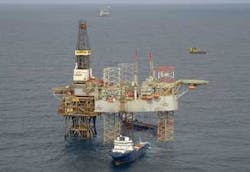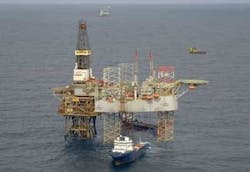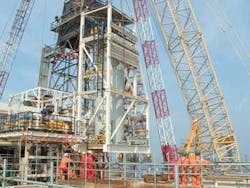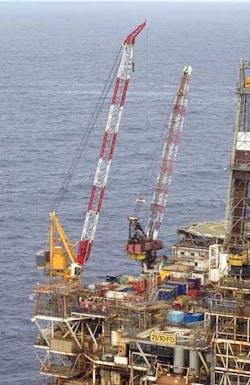Forties set for long haul following comprehensive renovation program
New 4D data suggests 800 MMbbl more in place
Jeremy Beckman, Editor, Europe
Forties, Britain’s largest offshore oilfield, is on the upward track after years of steady decline. The new operator, Apache North Sea Ltd., has doubled production following a comprehensive investment program over the past three years.
Based on extensive technical evaluations and campaign results to date, Apache has determined the original oil in place is larger than had been thought, extending the previous figure from 4.2 Bbbl to a level approaching 5 Bbbl. Coupled with the improved recoverable reserve outlook and modernization of the existing facilities, the company believes it is possible to sustain operations beyond 2030.
Apache assumed operatorship in April 2003 following fast-paced negotiations initiated by BP the previous fall. Since 1970, BP had been the field’s operator and majority stakeholder, overseeing progress from discovery through start-up in 1975, via four fixed steel production platforms. Over the next two decades it added two further platforms, upgraded reserves through new exploration and development, and improved recovery where possible through large-scale artificial lift programs.
By the turn of the century, however, Forties was viewed as a tail-end asset for BP and rather than committing to further investment, the company decided to pursue a suitable company for divestiture and to redirect those funds for capital investment toward other global endeavours. Based on an existing business relationship that included previous transactions, BP approached Apache in 2002 with a portfolio that also included properties located in the US outer continental shelf (OCS) in the Gulf of Mexico. BP divested its remaining OCS properties to Apache during 2006.
BP was aware that Apache had been looking for an entry into the UK North Sea for some time, but had not located a suitable acquisition opportunity. After evaluating BP’s Forties data-sets, however, Apache’s management were satisfied that this initial search was over. Kregg Olson, Apache’s VP of Corporate Reservoir Engineering, led a review of the field’s remaining production and drilling potential, forward operating costs and long-term abandonment liabilities. In an interview in the company’s newsletter ‘Arrows’, he stated: “We felt that BP’s model and our model compared favorably. We saw a lot of potential upside - it appeared that Apache could squeeze a lot more out of that field, as the assets had not been getting the attention that they needed.”
At the time of the acquisition, Forties’ remaining net proven reserves were just over 147 MMbbl, with forecast average production in 2003 of 45,100 b/d. At peak in 1979, the field had delivered in excess of 500,000 b/d. The price of transaction, agreed by the two parties in January 2003, was $683 million for Forties; the total package, including the GoM interests, was $1.3 billion.
Forties was discovered in October 1970 in 350 ft of water, 110 mi northeast of Aberdeen. Four appraisal wells drilled over the following year revealed a large, broad domal structure at a depth of around 7,000 ft, with a 600-ft oil bearing formation in Palaeocene Montrose group sands. Reservoir quality appeared to be variable - better in the central and northern areas, and diminishing somewhat in quality towards the southern and south-eastern sections.
The first-phase development was based around four large drilling and production platforms, Forties Alpha, Bravo, Charlie, and Delta, each with throughput capacity of 155,000 b/d of oil and 9,000 b/d of natural gas liquids. Charlie served as the main collection and export hub by transporting combined production to Cruden Bay, north of Aberdeen, via a 105-mi submarine pipeline. An overland 130-mi pipeline took the oil and NGLs southwest to a processing terminal near Grangemouth. Most of the surplus gas not required as fuel was flared.
All four platforms were also equipped for large-scale water injection and produced water treatment. In 1987, BP added a smaller minimum facility platform, Forties Echo, to develop the field’s southeastern extension. This installation lacked processing capability, so its production was sent to Forties A via a new 12-in. pipeline.
During 1988, the company mounted the first 3D seismic acquisition campaign with the aim to enhance imaging of the geological structural evaluation and ultimately pinpoint further pockets of oil trapped in the reservoir. In the early 1990s, it also initiated the first of two artificial lift programs to access further pools of oil, and to slow the field’s rate of production decline. This involved installing electric submersible pumps (ESPs) as well as gas lift on the main part of the field, at the same time putting in new dual-bore wellheads and christmas trees. Forties Echo also had ESPs in 10 of its wells, in this case to assist artificially lifting of the oil flow.
In 1991, the existing export trunk line was replaced with a new 36-in. diameter line between Forties C and Cruden Bay. This lifted throughput capacity from 630,000 b/d to 900,000 b/d. Two years later, BP tied in the new Unity riser platform (not part of the Apache package), which still serves as the reception point for oil from other fields in the area heading through the BP Forties pipeline system.
The transaction with BP brought Apache a 97.14% controlling interest in the Forties complex, the balance being held by Shell and ExxonMobil. Most of the existing offshore and onshore personnel remained under the new Apache management team, although some have since relocated to group operations elsewhere in the world, according to Jim House, regional VP and managing director of Apache North Sea.
House himself joined the company in the 1990s following its acquisition of MW Petroleum from Amoco and has been part of their international organization for the past ten years, including two assignments in Egypt. “Apache’s culture is to push accountability and responsibility deeper into the organization,” he says. “As a result, we find that activity and productivity goes up, while at the same time costs come down. I have personally witnessed this phenomenon virtually every time Apache makes an acquisition of this size and the employees of the previous company become part of the team.
“We do possess a different culture, and with the size of our operation, have the inherent ability to make quicker decisions as we pride ourselves on our sense of urgency. Our modus operandi is to challenge existing processes and procedures. Generally, we also want to accomplish things with fewer steps - without compromising safety - to ultimately improve the process of executing our business strategies.”
House implies no criticism of BP. “They did an excellent job developing and operating Forties while implementing the technology available at the time. Their work programs were successful, in particular their efforts to combat pressure decline to maintain production rates and sweep efficiencies. Although the field has a very large aquifer, the overall influx was not keeping up with withdrawals. But BP managed to get reservoir pressure back above up to 2,000 psi.”
Production, however, was heading in the wrong direction, despite the two new wells drilled by BP in 2001. When Apache came in, the forecast average output by 2006 was in the low 30,000 b/d range. Today, the actual figure is in excess of 70,000 b/d, with occasional surges to 80,000 b/d. “Our current field potential is actually over 85,000 b/d, if we’re batting 100%, which means all available completions are on line and optimized,” House adds.
These rates have been achieved by a combination of new wells, and a systematic upgrade of the platforms’ drilling and production facilities. “Typically,” House asserts, “most other operators would have shut the platforms down completely while performing the facility upgrades. But through proper operational risk assessments, we have kept these installations going while undertaking our various major work programs. By and large, we have also managed to maintain production growth during overhauls, which is one reason why we’ve been able to post increased output from Forties year on year.”
At the last count, there were 69 live production wells and 10 injectors. Apache has so far drilled 41 wells designed to access new reserves or to improve drainage. The 18-well campaign in 2005 added over 45 MMboe of new developed reserves, almost double the amount produced that year. Most of the wells have been re-drills or sidetracks from existing well bores.
“On the Forties Echo platform, we have extended well counts by using slots splitters, which involved running two 13 3/8-in casing strings within existing conductors. Another notable achievement included record 7-in. liner sections in the range of 3,500 m,” House says.
One to two jackups have been working on the field almost continuously since January 2003. During 2005, Apache contracted theGSF Galaxy III drilling rig for a 12-well program on the Echo platform. All five installations have fixed well bays, with 28 conductor slots immediately available across the field.
“This year we’re looking to drill 14 new wells across Forties,” House explains, “but the number of targets continues to evolve upwards. Based on slot availability as well as measures to reclaim others, we will be able to continue drilling from the existing platforms for a number of years.
“Through various measures, we’ve been able to impact drilling time and other efficiencies, which has dramatically lowered the cost of drilling wells in Forties. Using one less casing string is one way of doing this. We are employing rotary steerable drilling which is providing more stable well bores to access previously non-drained targets farther out from the platforms.
“Driving down well costs brings an added benefit, in that it allows us to target prospects with lower reserve levels than were previously pursued. The most recent Rushmore benchmarking exercise revealed that Apache has the best costs per foot in drilling performance from jackups in the Central North Sea.”
Noble is the main contractor for platform drilling, and Apache is also working with a wide range of well service providers. These include Aberdeen-based PSL for fluid pumping and wireline intervention work; and Qserv, which has installed coiled tubing-deployed ESPs in the Bravo platform wells. This exercise is an integral part of a direct export project, also contemplated during BP’s tenure, to switch Bravo’s production through the neighboring Charlie platform for processing and to provide a new source of gas for power generation.
To date, platform drilling packages have been upgraded on Forties Alpha, Bravo, and similar work is nearing completion on Charlie. These upgrades have involved restoring and recertifing the derricks, and installing new crown and travelling blocks, top drives, iron roughnecks, and mud handling equipment. Further, new state-of-the-art instrumentation systems have been installed to transmit data real time for both the rig and engineers in the office.
On Forties Echo, a new hydraulic snubbing unit has been ordered from PSL to assist with pulling and running of completions. This unit, currently undergoing factory acceptance tests, will replace an existing rental unit from PSL currently on the platform during the second half of 2006.
Upgrade work has always been staggered to minimize disruption to production and within limits of bedding on the platforms. “Our staff have tried to take advantage of opportune shut downs to tie-in new equipment to provide benefits ahead of established schedules.
“We’ve maintained two platform rigs in operation as part of our business plan for both drilling or workover operations, such as pulling or running artificial lift systems,” House adds.
Echo has witnessed the greatest production growth, recovering from a low of 1,000 b/d to 21,000 b/d at present. Output is lowest from Charlie, with no new wells there apart from one workover. But this will change following the transfer of the drilling crew from the Delta platform during July of 2006.
Last summer, a CGG vessel acquired the fourth 3D seismic data set over Forties, and the first under Apache’s stewardship. Concurrently, Apache is performing a 4D time-lapse evaluation in an attempt to better define the field’s remaining potential. Initial studies integrated data from BP’s three previous 2D and 3D surveys in 1988, 1996 and 2000. “We were looking for variations in acoustic impedance and changes in rock fluid density,” House explains. “In terms of its geological setting and related petrophysics, Forties is a perfect candidate for modelling fluid density changes within the reservoir.”
Using Schlumberger’s Petrel software integration package, a multi-disciplinary team of geologists, geophysicists, production and reservoir engineers developed and refined a new full-field reservoir model. This has been applied to identify non-drained areas of the reservoir, with practical results already in house. In one instance, a well in the Delta-Echo channel was re-directed to intersect a previously unknown 20-m oil column. The new model will also aid placement of future water injectors to maintain reservoir pressure and to extend ultimate recoveries.
More significantly, the new models illustrate that the original oil in place is larger than previously estimated, rising from 4.2 Bbbl to 5 Bbbl. The Forties field has already recovered in excess of 2.5 Bbbl, House adds. “We’re imaging the main reservoir channels, and yes, we’re seeing pockets of oil throughout. But the overall picture remains somewhat complex, with varying saturations, trapped oil, or pay in cases within deeper-lying sands or shallower thin beds.”
A sharper overview should emerge with data now being factored in from last year’s 3D survey. “So far, we’ve identified over 70 firm targets, with potentially 50 more to follow up. Essentially, we have a resource style development play within Forties with overall reserve potential approaching 300 MMbbl. We currently have a team developing a concerted strategy to access those reserves, as this program will require additional facilities and other supporting infrastructure.”
BP’s gas-lift program in the early 1990s involved injection at “shallow” and “deep gas lift” sections of the completions. Apache has started a project to upgrade the existing gas lift equipment. “We’re currently installing new deep gas lift compressors on both the Alpha and Delta platforms, each capable of delivering 20-25 MMcf/d at 2,000 psig. The new compressors will improve uptime, and provide redundancy with the added ability to operate in parallel with the existing system. Ultimately, we will be able to increase available gas lift supply and move significantly more fluids.”
During its final years as operator, BP formulated plans to improve communications and power supply across all the platforms. One scheme that did go ahead was the installation of new fiber optic cable to the field and the provision of a high bandwidth telecommunications network between onshore and offshore. This enabled efficient real time data transmission for drilling and platform control and monitoring systems. Another scheme to install a power cable to the field to improve system reliability was not sanctioned. This would have involved running long-distance, high voltage subsea power cables from shore and tying in various BP production complexes.
In its search for an alternative, reliable source of power to replace the aging and unreliable turbines installed in the 1970s, Apache opted for an infield solution generating power from four new 13MW Solar Titan machines, two on Alpha and two on Charlie, and a “ring main” which distributes power and surplus gas to the five platforms via a 4.5-in. pipeline and 33 kV power cables. The power and gas ring main project, at an investment cost of £25 million, has already been commissioned.
The scheme will reduce flaring to a minimum (all available gas will be required for power generation), and also cuts diesel fuel requirements, leading to savings of $3 million per month. The new Titan generators on Charlie have already been installed and commissioned with power currently being exported to both Alpha and Echo. Installation of the second pair of Titan generators on Alpha is slated for delivery in 4Q 06, with full field distribution commissioned by the end of the year.
Provision of the new power generators will ultimately require an investment of £65 million and will increase field generation capacity by 67%, or an additional 20MW. This should improve system reliability, increase facility uptime and reduce power generation maintenance and operating costs.
“We develop annual business plans, and then the scope and scale change as program successes brings additional development prospects,” House says. “That could likely mean installing additional power generation at some point.”
Installing the new generators and increasing field generation capacity has enabled other improvement projects to go ahead. “There was also a significant reliability issue concerning the platforms’ main oil line (MOL) pumps. These were driven individually by 30-year old gas turbines nearing the end of their useful life and requiring intensive operations and maintenance.
“We’ve installed new electrically-driven MOL pumps on Charlie to improve reliability and reduce operating and maintenance costs. Previously there wasn’t enough power on Charlie for electric driven pumps. The power consumption would have exceeded the capacity of the old generators.”
Another major new project involves implementing high pressure produced water re-injection (PWRI) to complement the existing water handling regime. Past re-injection performance has been mixed, with substantial reliability and injection issues at relatively low injection pressures of 1,000 psig.
“The new kit will allow us to re-inject 150,000 b/d of water from both Alpha and Charlie platforms at high pressure (2,400 psig) - the kit will include new high pressure pumps and sand removal cyclones, ensuring we meet our oil to sea environmental and operational requirements. We will also have the ability to re-inject produced water from the recently installed PWRI Charlie to Bravo by pipeline, removing the need to support reservoir pressure from Bravo with seawater.
“It’s a major step to enhance oil recovery, improving waterflood efficiency and increasing reservoir pressure support. And from what we’re seeing from our 4D and reservoir simulation work, by expanding system capability we should be able to further increase oil recovery. Contingencies have already been made to upgrade the system and from what we’re seeing from our 4D work, there may be a need in future for further expansion of these systems.”
The improvement efforts don’t end there. “Elsewhere, our operation was significantly challenged with the platform control systems, much of which date back to the 1970s and were modified over the years. That left us with a complex mix of old and new, unreliable systems that were difficult to problem solve and maintain. We’re solving that by putting in new centralized control and monitoring systems, bypassing most of the old wiring. The new systems will be more reliable, and much easier to operate and maintain.”
Another improvement relates to the replacement of the old cranes on the main platforms. “There were three big cranes on each platform. Similar to other existing equipment, they were old and maintenance intensive. We’ve put in two new state-of-the-art cranes on each platform consisting of one large and one small unit. These will only need a fraction of the maintenance effort we were expending trying to keep the old cranes operable. Getting all this work has involved extensive efforts from the offshore crews. But there’s no question the new equipment upgrades has boosted staff morale.”
As for the platforms themselves, structural strengthening was never on the agenda. “Looking back, we can say that the four original installations, all dating back from the early ’70s, were if anything over-engineered from a structural point of view. That’s a good thing now, as by and large the structures are in excellent shape. We have made some relatively minor structural changes, based on loading requirements for some of the new modules.
“Once you get into a project of this type, you are constantly identifying new issues that need addressing. Yes, we have spent more on upgrades than we originally envisioned. To date, we have spent more than $683 million on the original acquisition, a total of $800 million on related projects and rig operations, and another $500 million on operating costs.” Apache also had an agreement with BP to perform maintenance on the Unity riser platform for the first three years. Charlie will continue to host production from Talisman’s Buchan field, and to provide pipeline pigging operations for the Montrose and Brae fields.
One cumulative effect of all the work to date has been a big increase in Forties’ overall production efficiency to 88%. “By that, we mean that we are producing at 88% of all the well’s combined capabilities, taking into account tripping or other problems downhole. That’s a pretty good rate: the UK Department of Trade and Industry lists 84% as the average for North Sea fields.”
Looking at the bigger picture, Apache aims to firm up and exploit the extra reserves identified on the 4D seismic. “We’re developing our strategy on how to access up to another 200 MMbbl,” House says. “At the same time, keeping costs in line will be a big issue. But we do think that it’s a very strong play. We could kick off that project late next year.” With limited slot availability, one possibility could be to add production through new unmanned wellhead towers.
Apache ruled out subsea tiebacks for its earlier discoveries, with so much established well infrastructure in place. But subsea might be an option for developing future reserves. There is also the possibility of tying back the nearby 2004 Bacchus oil discovery in block 22/12a either to Forties or to Shell’s Nelson platform. The semisubmersible drilling rigPetrolia is due to arrive at the Bacchus location early in September for appraisal drilling.
The Forties oil pipeline system, still operated by BP, is currently transporting 650,000 b/d from Forties and other fields in the area. It will also shift output from Nexen’s Buzzard field, due onstream shortly, but there should still be ample ullage for future Apache full-scale or incremental developments. Any associated gas would probably be routed to the Forties ring main.
Last year’s 3D seismic campaign was also extended to other Apache-operated UK blocks, including 16/29, containing the decommissioned Maureen and Moira oilfields, and other blocks west of the producing Everest and Fleming fields. Apache remains open to further large-scale acquisitions elsewhere in the North Sea.
As for Forties, “we’re getting through Phase 1 of our development plan, focusing on restoration of the platforms, and we’re definitely building an operation to last,” House says. “These programs will take Forties forward 20 years and more. And there will be continual programs of work and additional upgrades, including to platform accommodations.”




